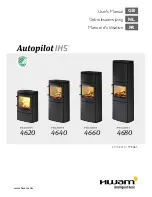
4
Make sure that the room in which the pellet boiler is installed has a sufficient amount of clean air, which guarantees
proper combustion. The air intake pipe should be of a minimum outer diameter of 110 mm and of a maximum length of
10 m. For every 90˚ elbow the maximum length is reduced by 1 m. If the length is too large, it is necessary to increase the
diameter of the air supply pipes.
If the grating is placed on the façade, the area of the air inlet port must be at least 100 cm
2
or larger.
The device works on 220-230 V, 50 Hz voltage. Make sure that the cables for electrical connection do not pass under the
boiler, that they are installed away from heated surfaces and that they do not come into contact with sharp objects that
may damage them. If the pellet boiler is under increased electrical voltage, the durability of electrical components will be
greatly reduced.
Do note remove the plug from the socket in order to switch off the boiler until the flame in the boiler is extinguished.
THE FLUE GAS EXHAUST SYSTEM
The flue gas exhaust system shall be in accordance with the applicable regulations. Do not connect the flue pipe of the
boiler to the chimney to which other furnaces are connected (Figure 3). The flue gas exhaust system must not end in a
closed and/or in semi-enclosed areas, such as garages, narrow passageways, hallways, sub-corridors and the like. After
connecting the boiler to the chimney, an authorized chimney sweep should check if there are any damages in the
connection and whether the connection is properly sealed. If the chimney is not suitable it must be executed in
accordance with the foregoing requirements (Section 3.1).
Figure 3
An uptake should be grounded in accordance with the applicable regulations. (Grounding is legally defined and
regulated.)
Grounding should be independent of the heating unit.
As far as dimensions and material are concerned, the flue pipe must meet the UNI 9615-9731, UNI 10683 – EN1856-1
standards.
Poorly preserved flue pipes or flue pipes made of inappropriate material (asbestos, galvanized sheet metal, porous
materials) do not comply with applicable regulations and adversely affect the operation of the boiler.
Flue gases can be discharged via the conventional chimney (see figure below) if the following requirements have been
met:
-
Check if the chimney is maintained. For proper maintenance and/or restoration contact the chimney sweep.
-
Flue gases can be discharged directly into the stack only if it is equipped with an inspection hole and if the
chimney is not larger than 20 X 20 cm, i.e. if the diameter is not larger than 20 cm.
-
If the chimney is larger, appropriately insulated stainless steel tube (of a corresponding diameter) should be
inserted in it.
-
Make sure that the chimney connection is properly sealed.
-
Avoid contact with combustible material (ember) and in any case, install flame retardant insulation.
When fittings are used for connecting the pellet boiler to the chimney, elbows equipped with a cleaning hole shall always
be installed (Figure 4). Using the elbow with a cleaning hole enables routine cleaning without the need for dismantling the
pipe. Exhaust gases in the chimney connector are under slight pressure, thus it is necessary to make sure to check that
the cover for ash cleaning is completely hermetically sealed and that it is closed tightly after each cleaning. Make sure
that everything is properly put back in its place and check the condition of the seals.
Содержание GRANDE 37
Страница 27: ...24 13 DIMENSIONS OF BOILER GRANDE 37 Figure 15...








































